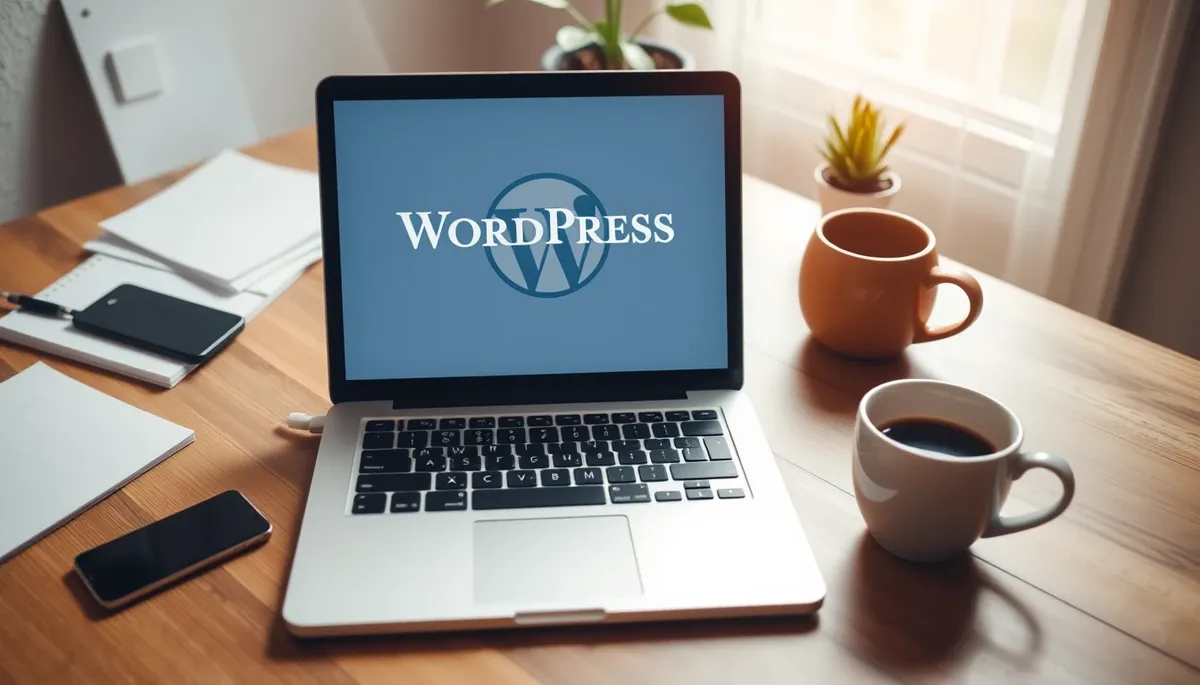Creating a WordPress site can seem complicated, but the process is relatively straightforward. To start, you need to select a reliable web hosting service and register a domain name.
Certain services, such as DigitalOcean, Bluehost and SiteGround, offer WordPress installation with a single click, making setup easier.
After installation, we will just need to configure basic site details and become familiar with the WordPress Admin Panel and beyond.
This initial setup is essential for building and customizing a website. The next steps involve turning our ideas into a working WordPress site.
TL;DR
Hide- Choose a reliable hosting provider like DigitalOcean, Bluehost or SiteGround for optimal performance.
- Register a domain name and complete the one-click WordPress installation.
- Familiarize yourself with the WordPress Admin Panel to manage your site's settings and content.
- Select and customize a theme from the WordPress Theme Directory to align with your brand.
- Install essential plugins like Yoast SEO and Wordfence Security to enhance functionality and security.
Introduction to WordPress: A Beginner’s Guide

When I first ventured into creating my own website, I was faced with the daunting task of choosing the right platform to build it on.
After exploring various options, I discovered WordPress, which turned out to be the perfect fit for my needs as a beginner.
When you’re starting a website, choosing the right platform is vital, and that’s where WordPress shines.
It’s user-friendly, highly customizable, and powers over 40% of all websites on the internet.
Let me show you why WordPress might be the perfect fit for your online presence.
Why Choose WordPress for Your Website?
In 2008, I started blogging using Google’s Blogger platform and found it relatively easy and fast to share thoughts online through blog posts.
Later, in 2011, I switched to Blogdetik, a free WordPress multi-site available in Indonesia. This was my first experience with WordPress, and I was impressed by its ease of use.
After blogging for several years, I decided to create my own website with my own domain name.
When considering this, I discovered that WordPress offered several advantages over other content management system options and then built my first ever WordPress site with my own domain name, called Seni Berpikir and followed by my personal travel blog soon after that.
WordPress stood out to me because of its user-friendly interface and flexibility.
I lacked experience in web development, so I needed a platform that was easy to use and had the capacity to grow with my goals.
WordPress strikes a balance between being simple enough for beginners and offering advanced features for more experienced users.
What initially drew me to WordPress was its open-source status, which makes it free to use and allows a community of developers to continually improve and update the platform.
A wide range of available themes and plugins enabled me to customize my site without needing to write code. I could change the website’s appearance with just a few clicks, making it my own.
Or I’ll just use a WordPress child theme to do customization without the risk of being overridden when the parent theme gets updated.
The Benefits of Using WordPress Over Other CMS
Choosing the right Content Management System (CMS) can feel like traversing a labyrinth, but WordPress stands out as a beacon of simplicity and versatility.
It’s open-source, offering endless customization without hefty costs. Plus, its massive community guarantees constant innovation and support.
With user-friendly interfaces and flexibility, WordPress empowers you to create unique, dynamic websites, making it a superior choice over other CMS options.
Key Features That Make WordPress the Ideal Choice
WordPress isn’t just popular because of its ease of use and flexibility; its key features truly set it apart, making it the go-to choice for website creation.
It offers a vast library of plugins, customizable themes, and a user-friendly interface. Plus, its SEO capabilities are exceptional, ensuring your site ranks well. With WordPress, you can innovate and scale effortlessly.
Setting Up a WordPress Site
Let’s get started with setting up your WordPress site by choosing a reliable hosting provider and installing WordPress.
After that, I’ll guide you through exploring the dashboard to help you get familiar with its features.
You’ll be ready to create and manage your content efficiently in no time.
Choosing a Hosting Provider and Installing WordPress
To kick off your WordPress journey, the first step involves selecting a hosting provider that suits your needs and then installing WordPress on that platform.
Choosing the right host can make or break your site’s performance, so prioritize speed, uptime, and customer support. Popular options include DigitalOcean, Hostinger, Bluehost, SiteGround, and WP Engine, each offering one-click WordPress installations.
Once you’ve picked a host, sign up for a plan that matches your ambitions. Most providers guide you through the process, but you’ll typically start by registering a domain name.
This is your site’s address, so make it unique and memorable.
Next, you’ll install WordPress. With one-click installations, this is a breeze. Log into your hosting dashboard, locate the WordPress installer, and follow the prompts.
You’ll need to set up basic site information like the site title, username, and password. Within minutes, your WordPress site will be live.
This seamless process empowers you to focus on what truly matters: creating innovative, engaging content.
Navigating the Dashboard: A General Overview
When you first log into your WordPress site, the dashboard can seem overwhelming, but don’t worry—I’ll guide you through the key sections of the admin panel.
Understanding areas like Posts, Pages, and Settings will help you manage your site efficiently.
Let’s break down each section to make your WordPress experience smoother.
Key Sections of the WordPress Admin Panel
Traversing the WordPress Admin Panel can initially feel overwhelming, but understanding its key sections is crucial for efficiently setting up your site.
Focus on these areas: the Dashboard for an overview, Posts for your content, Media for your images, Pages for static content, Comments for user interaction, and Appearance for design customization.
Mastering these sections will streamline your workflow and release your creativity.
Customizing a WordPress Site
Now that you’ve set up your WordPress site, it’s time to make it truly yours by selecting and personalizing a theme.
I’ll show you how to enhance its functionality with essential plugins, making your site not only beautiful but also powerful.
Ready to transform your website? Let’s get started!
Selecting and Personalizing a Theme
Choosing the right theme for your WordPress site is crucial, as it often determines the overall look and feel of your online presence. Start by exploring the WordPress Theme Directory, where countless free and premium themes await.
Look for a theme that aligns with your brand’s vision and offers a responsive design to guarantee it looks great on any device.
Once you’ve chosen a theme, it’s time to personalize it. Head to the WordPress Customizer, where you can tweak elements like colors, fonts, and layouts.
Don’t be afraid to experiment; this is where your creativity can shine. Add your logo, adjust the header, and customize the homepage to reflect your unique style.
Remember, a clean, intuitive design enhances user experience and keeps visitors engaged. Make sure your theme supports essential features like SEO optimization, fast loading times, and compatibility with major browsers.
This guarantees your site not only looks good but performs well too.
Incorporate innovative design elements like parallax scrolling or custom widgets to stand out.
Personalizing your theme isn’t just about aesthetics; it’s about creating an immersive experience that resonates with your audience.
Enhancing Functionality with Essential Plugins
Let’s plunge into enhancing your WordPress site’s functionality with essential plugins. Plugins are the backbone of a dynamic WordPress site, transforming a simple blog into a powerful platform.
First, consider installing Yoast SEO. It’s a game-changer for optimizing your content, helping you climb search engine rankings.
Next, for security, I recommend Wordfence Security. It provides robust protection against threats, ensuring your site remains secure.
For performance enhancement, WP Super Cache is a must-have. It speeds up your site by caching static pages, improving user experience and SEO.
If you’re looking to add e-commerce functionality, WooCommerce is unbeatable. It’s flexible, and scalable, and integrates seamlessly with your site.
For form building, WPForms is intuitive and versatile, perfect for creating contact forms, surveys, and more.
Don’t forget to integrate Google Analytics with MonsterInsights. It simplifies tracking your site’s performance, giving you actionable insights.
Securing and Optimizing a WordPress Site
When securing and optimizing my WordPress site, I start with basic security measures like strong passwords and regular updates.
I also focus on improving performance by optimizing images and leveraging caching plugins.
Ensuring mobile responsiveness is vital, so I use responsive themes and test my site on various devices.
Basic Security Measures I Implement
Guaranteeing your WordPress site is both secure and optimized is crucial for maintaining its performance and protecting it from potential threats.
One of the first steps I take is to use a strong, unique password and change the default “admin” username. This simple action can thwart many automated attacks.
Next, I always keep WordPress, themes, and plugins updated. Updates often include security patches that address vulnerabilities.
Using a reputable security plugin, like Wordfence or Sucuri, adds an extra layer of protection by providing features like malware scanning and firewall support.
I also implement two-factor authentication (2FA) for an additional security layer. With 2FA, even if someone guesses my password, they can’t access my site without the second verification step.
Regular backups are essential; I use services like UpdraftPlus or BackupBuddy to confirm I can quickly restore my site if needed.
Limiting login attempts helps prevent brute-force attacks. I configure this through my security plugin settings.
Furthermore, I enable SSL to encrypt data between the server and users, enhancing overall site security and boosting SEO.
Improving Performance and Mobile Responsiveness
To enhance both performance and mobile responsiveness on my WordPress site, I first focus on optimizing the loading speed. Fast websites not only improve user experience but also boost SEO rankings.
Here’s what I do to achieve that:
- Use a Reliable Hosting Provider: A good hosting provider guarantees the server response time is minimal, which is vital for speed.
- Optimize Images: Compress images without losing quality using plugins like Smush or ShortPixel.
- Leverage Browser Caching: Store parts of my website in users’ browsers to reduce load times on repeat visits.
- Implement a Content Delivery Network (CDN): Distribute content across multiple servers to guarantee quick access from anywhere in the world.
- Minify CSS, JavaScript, and HTML: Reduce file sizes by removing unnecessary characters, speeding up the load times.
For mobile responsiveness, I use a responsive theme and test my site on various devices.
I also guarantee my design is touch-friendly and that text and buttons are easily readable and clickable on smaller screens.
Launching and Growing a WordPress Site
When you’re ready to launch your WordPress site, to guarantee a seamless experience, start with a thorough pre-launch checklist to verify everything runs smoothly.
Once your site is live, I’ll share key strategies for growth and tips on regular maintenance to keep it thriving.
Let’s get started on making your WordPress site a success
Pre-Launch Checklist
Launching a WordPress site can be an exciting yet intimidating task, and having a solid pre-launch checklist is essential. Trust me, you don’t want to miss any vital steps that could derail your launch.
- Secure Your Site: Install an SSL certificate and enable security plugins to protect against cyber threats.
- Optimize for Speed: Use caching plugins, optimize images, and choose a reliable hosting provider to guarantee fast load times.
- Set Up SEO: Install an SEO plugin like Yoast or Rank Math, and make sure your permalinks are optimized for search engines.
- Test Responsiveness: Verify your site looks great on all devices. Use tools like Google’s Mobile-Friendly Test to confirm.
- Backup Your Site: Set up automated backups with plugins like UpdraftPlus to safeguard your content.
Following these steps will give you confidence and clarity as you prepare to launch.
Take the time to go through each item meticulously. The effort you invest now will pay off with a successful, innovative WordPress site that stands out.
Don’t cut corners—your site’s future depends on it.
Strategies for Growth and Regular Maintenance
A few key strategies can make all the difference in growing and maintaining your WordPress site.
First, prioritize SEO from the get-go. Use plugins like Yoast SEO to optimize your content and meta descriptions. High-quality content that targets relevant keywords will drive organic traffic.
Also, regularly update your blog with fresh, engaging posts to keep readers coming back.
Next, leverage social media to amplify your reach. Share your posts on platforms where your audience hangs out. Integrate social sharing buttons on your site to make it easy for visitors to spread the word.
Don’t neglect site speed; a fast-loading site improves user experience and search rankings. Use caching plugins and optimize images to guarantee quick load times.
Regular maintenance is vital. Keep your WordPress core, themes, and plugins up to date to avoid security vulnerabilities.
Schedule regular backups using plugins like UpdraftPlus, so you can quickly restore your site if anything goes wrong.
Lastly, analyze your site’s performance using tools like Google Analytics. Understand what works and refine your strategies accordingly.
With these tactics, you’ll not only launch a successful WordPress site but also guarantee its sustained growth and health.
Conclusion: WordPress Site Journey
As we wrap up our WordPress site journey, it’s crucial to highlight key takeaways and offer tips for continued learning.
I’ll also share some recommended resources that have been invaluable to my own WordPress experience.
Let’s guarantee your path to WordPress success is clear and well-supported.
Key Takeaways and Tips for Continued Learning
Throughout my WordPress site journey, several key takeaways have emerged that can enhance your experience and proficiency.
Embracing these insights won’t only streamline your process but also foster creativity and innovation in your projects.
Key takeaways include:
- Stay Updated: WordPress is constantly evolving. Regularly updating your themes, plugins, and WordPress itself guarantees you have the latest features and security patches.
- Leverage Plugins Smartly: Plugins can add powerful functionality but choose them wisely. Too many plugins can slow down your site and create security vulnerabilities.
- Focus on SEO: Optimizing your content for search engines is essential. Use SEO plugins, like Yoast, to guide you in improving your site’s visibility.
- Engage with the Community: The WordPress community is a treasure trove of knowledge. Participate in forums, join local meetups, and follow influential WordPress bloggers.
- Practice Makes Perfect: The best way to master WordPress is by building and experimenting. Try new themes, plugins, and customization techniques to see what works best for you.
Recommended Resources for Fellow WordPress Users
Building on the insights and tips shared, I’ll now point you towards some invaluable resources that can elevate your WordPress journey.
These tools and platforms are designed to help you streamline your workflow, enhance your site’s functionality, and stay current with the latest trends and practices.
| Resource Name | Description |
|---|---|
| WPBeginner | Exhaustive tutorials and tips for beginners |
| Smashing Magazine | Latest web design and development trends |
| Yoast SEO Blog | Expert SEO advice and best practices |
| WordPress Codex | Official documentation and developer guides |
Firstly, WPBeginner is your go-to for clear, step-by-step tutorials that simplify complex tasks. They cover everything from basic setups to advanced customizations.
Smashing Magazine, on the other hand, keeps you updated with the latest trends in web design and development, ensuring your site remains cutting-edge.
For those looking to optimize their site for search engines, the Yoast SEO Blog offers expert advice on improving your site’s visibility and ranking.
Finally, WordPress Codex provides in-depth documentation for developers, making it a treasure trove of knowledge for anyone looking to dive deeper into WordPress’s capabilities.



